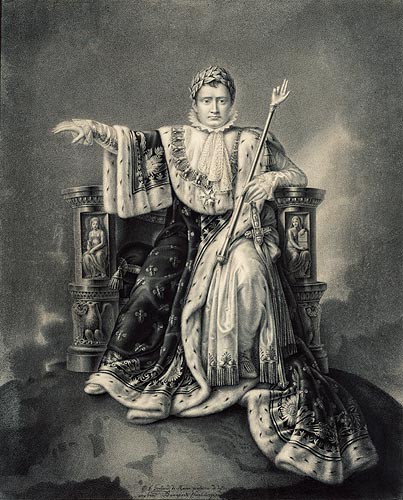It was at the Salon of 1810 that Goubaud first made his name, with a painting entitled, A deputation from the Roman Senate offering its homage to H. M. the Emperor and King, a work purchased by the government and which today hangs in the museum at the Château de Versailles. He was to present four drawings at the Salon of 1812: a scene from the baptism of the Roi de Rome (Goubaud had been appointed his drawing master), a portrait of the child, and two pencil portraits of the imperial couple, of which the drawing here was one.
A letter written at the Tuileries, dated 28 February, 1813, from the Préfet du Palais, the Baron de Bausset, to Champagny, Duc de Cadore, Intendant général of the Crown, reported on the successive presentation of these portraits to the emperor: June 1811, for the first of the drawings, and 26 March, 1812, for the second. Napoleon was so delighted with the allegorical portrait of him in the 'grand costume' coronation robes, sitting on a throne set on a globe, that Gobaud received gratification of 6,000 francs and a commission to do a portrait of Maire-Louise to match this one. When the Duc de Cadore asked Vivant Denon how much he should pay for the second portrait, the director of the Musée Napoléon (Louvre) replied that since the fee for Gobaud's first drawing «was only because of the munificence of His Majesty or a generosity towards the patrons of this artist», it could not be used as a basis for estimating the price of the second. And so Goubaud only received 3,000 francs, (a considerable sum, nevertheless) for the portrait of Marie-Louise (today held at the Napoleon Museum in Arenenberg).
whilst it is true that this portrait is not outstanding for its artistic qualities – the pose is rigid, and the draughtsmanship heavy -, it nevertheless received the emperor's approval. His satisfaction probably derived not just from the almost divine image of the emperor in majesty and the evocation, to the right of the throne, of his work as legislator, but also the technique used, namely, Conté pencil. The engineer Nicolas-Jacques Conté (1755-1805), one of the intellectuals who took part in the Egyptian Expédition invented a new sort of pencil lead made from baked clay and graphite taken from mines in the Alps (patented in 1795) – previously pencil lead had come from Britain.
After the fall of the regime, Goubaud remained faithful to the emperor. An exile in Britain, he was marked out by Louis XVIII's political police as a die-hard Bonapartist, and he played a small role as agent in 1831 and 1832, sent by Queen Hortense and Louis Napoléon to Joseph in the United States, and then by the latter to the Duc de Reichstadt in Vienna.
Karine Huguenaud (tr. P.H.)
February 2005
Allegorical drawing to the glory of H. M. the Emperor
Artist(s) : GOUBAUD Innocent-Louis

- Date :
- 1811
- Technique :
- Black pencil
- Dimensions :
- H = 71.1 cm, L = 57.5 cm
- Place held :
- Paris, Fondation Napoléon, acquisition 1992
- Photo credit :
- © Fondation Napoléon - Patrice Maurin-Berthier

